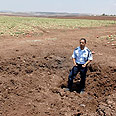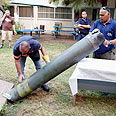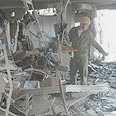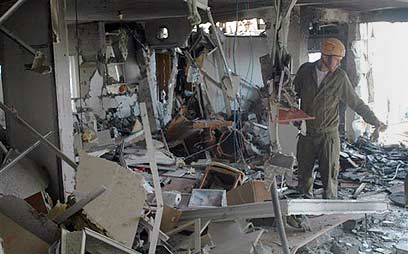


Ynet has learned that parts of the rockets fell off while they were in transit, but caused no injuries or damage.
An examination by security forces revealed that the rockets were fired from over a 100-kilometer range, apparently from the Lebanese town of Tyre. Police sappers are currently inspecting the rockets' parts and have been able to determine that they are probably old Syrian 302 rockets.
Palestinians 'overjoyed' by rocket attacks
Palestinian witnesses in the Jenin area, who noticed the rocket parts which fell between Beit Shean and Afula, said the rocket appeared to have fallen in the Gilboa area.
A Fatah activist from Jenin added that the rocket hit was heard clearly around the city, and a spark and a flame were also clearly seen.
The Fatah member related that local residents cheered when they heard the rocket fall and saw the resulting flames. “Even if it were to fall on our heads, it wouldn’t have spoiled our joy. All of us here are praying for Hizbullah’s success and victory," he said.

Rocket destruction in Tiberias (Photo: Gil Eliyahu)
He noted that in Jenin, Palestinians were convinced that the Israeli army was being squarely defeated in Lebanon, with proof implicit in Wednesday’s massive rocket barrages and the extension of Hizbullah attacks to the valley area, plus the IDF’s difficulty in entering deeper into Lebanese territory.
Hizbullah's rocket cache
Hizbullah, for its part, claimed Wednesday afternoon that its operatives launched over 300 rockets towards Israel since the early morning. Israel reported that over 70 rockets landed in its territory.
Roughly one-and-a-half weeks ago, for the first time Hizbullah fired five rockets which were defined by police as long-range missiles, bearing a larger amount of explosives than those fired up until then. The Fajr-5 rockets landed in open areas around Afula and in the area around Afula and south of Afula towards the Beit Shean valley.
Shortly after the launch of the longer-range rockets, Hizbullah published a message confirming that it attacked Afula, but noted that it used a Khaiber 1 missile for the first time. The message said, “This shall open a new phase in the confrontation against the enemy, as this rocket has a range of 50 kilometers. This is the surprise Nasrallah promised in his last speech when he said the organization would attack beyond Haifa.”
“If the enemy continues its aggressions,” the message continued, “the next stage will arrive in which we’ll attack far beyond Haifa.”
Early this week, the IDF revealed new data which re-assessed Hizbullah’s rocket capability and the blow dealt to the organization by IDF operations in south Lebanon. According to the army, Hizbullah’s cache of 220-mm rockets, which caused the damages in Haifa, was significantly diminished, having been halved from roughly 400 to 200.
In addition, a senior government official told Reuters that the IDF destroyed two-thirds of Hizbullah’s long-range Zelzal missiles. However, the data concerning short-range rocket capabilities was less encouraging. Hizbullah is still in possession of some 10,000 of these rockets.
Roee Nahmias contributed to the report















